Are you a Quiet Speculation member?
If not, now is a perfect time to join up! Our powerful tools, breaking-news analysis, and exclusive Discord channel will make sure you stay up to date and ahead of the curve.
Testing. It is the soul of tournament play. Honing and crafting your deck and play, optimizing them to dominate the competition. The eternal quest for the glory of victory on the back of your own creation! It is this siren's call that keeps us playing and the dream that drives us forward.
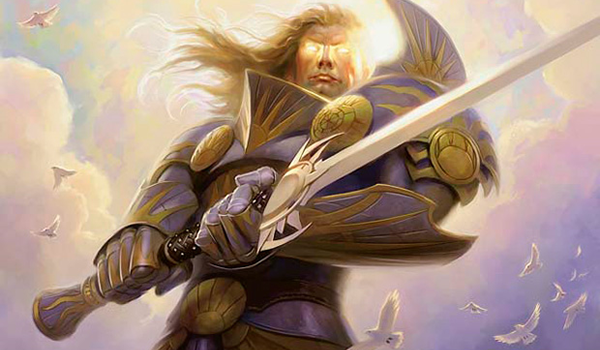
Of course, anyone who has ever tried this knows that sometimes your creation ends up making Stitcher Geralf's creations look like Serra's. Testing can easily get inbred and sometimes it can just be wrong, either due to incorrect assumptions or simply missing something. If it was easy, it wouldn't be worthwhile. This is part of that aforementioned allure and makes the success all the more memorable.
And then there are those times that you have results that you can't interpret. Those times when the data from one session points one way, the second set points another, and your test partners' results contradict everyone else's. Those inconclusive, confusing, convoluted results. I know most players cannot stand them and will abandon decks that produce these kinds of results, but (and I freely acknowledge that I'm quite weird) I love these results. This might just be my academic background talking (you can get multiple papers out of unexplainable, inconsistent results without coming up with a new topic!) but I love the process of untangling the confusing and exploring the unexplainable. Even when it invalidates all the time I've spent preparing for a tournament.
[wp_ad_camp_1]
Finding the Control Deck
Last week I mentioned that my testing for States did not go well, which left me to default to my usual Merfolk deck. While I realize that may sound like it was all wasted, I actually got a lot of very useful information out of it. The problem was that I mostly just figured out what not to do. Chiefly: Don't try to squeeze Thopter combo into a deck arbitrarily, and Ancestral Vision doesn't work in most decks.
The Thopter Problem
I have always been skeptical of the Sword of the Meek unban. Remembering its dominance from 2010, I genuinely thought it a dangerous and unwise decision and was 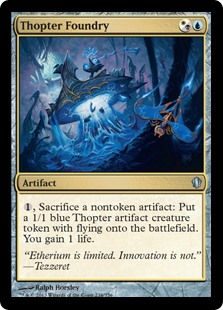 convinced that the deck would cause problems. I no longer stand by that belief. This is not because I was wrong about what the combo is or its power. What I didn't fully understand was how much Magic has changed in the last six years, not just in terms of the answers to the combo (everyone recognized that) but in how decks function these days. The ability of decks to pressure each other and to do so from multiple angles has gotten much better and the fact is that you can't spend as much time durdling and tutoring these days as you could in 2010.
convinced that the deck would cause problems. I no longer stand by that belief. This is not because I was wrong about what the combo is or its power. What I didn't fully understand was how much Magic has changed in the last six years, not just in terms of the answers to the combo (everyone recognized that) but in how decks function these days. The ability of decks to pressure each other and to do so from multiple angles has gotten much better and the fact is that you can't spend as much time durdling and tutoring these days as you could in 2010.
This makes Thopter combo much worse since unlike other combos its pieces are do-nothings on their own. Deceiver Exarch and Splinter Twin were reasonable cards on their own and every piece of the Stoneforge Mystic package is good, while Sword literally does nothing without the Thopter Foundry, which is mediocre at best on its own. This means that I was very wrong about how many pieces you had to play to make it work and how universal it could be.
I tried to just stick three Foundrys and two Swords into a UW Control shell and it failed badly. It was too hard (even with Ancestral Vision) to actually assemble the combo. Trying to solve this problem pushed me initially towards Gerry Thompson's build, which I'm not convinced works unless you are also Gerry Thompson. Trying to move away from the Gifts package ended in a weird KCI/Affinity/Thopter hybrid that looked great on paper but in practice just lay down and begged for death to end its suffering. 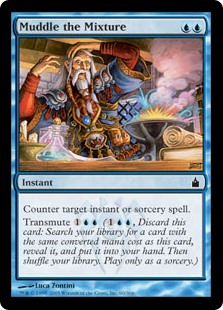 In the end I went a completely different route of including the combo as part of a Muddle the Mixture tutoring package in a control deck that was okay, but was not exciting or particularly good so I ended up scrapping it. It turned out to be a normal UW Control list with a wonky, unreliable win condition.
In the end I went a completely different route of including the combo as part of a Muddle the Mixture tutoring package in a control deck that was okay, but was not exciting or particularly good so I ended up scrapping it. It turned out to be a normal UW Control list with a wonky, unreliable win condition.
If you're going to make the combo work, it needs to be as part of a deck that is good on its own and already contains the tutoring necessary to assemble the combo reliably. Gerry is probably on the right path but I'm withholding praise until I see more people win with his deck. Muddle is incredibly slow in Modern and I'm not convinced that it's good enough as either a counterspell or a tutor to see play. Maybe someone will find the right shell for it, but all my testing has shown is that it's just not worth the effort to assemble the Thopter combo. There are better, more reliable win conditions.
The Ancestral Problem
I was right about Ancestral Vision. This might not seem like a problem but it took a lot of effort for me to conclusively confirm my suspicions. I know that Ari Lax said nearly the same thing I did at about the same time but that's no excuse not to test. It's easy to let theory dictate reality, which is the opposite of how it should be, so you have to actually test. But I was right.
I know that Vision appears to be a draw-three for one blue. You just have to wait between 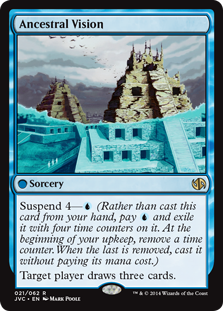 payment and payoff. That's not so burdensome, right? Actually, yes it is. Treasure Cruise was good because the immediate payoff helped you right then. With Ancestral you have to A) Survive until it comes off suspend and B) Resolve it.
payment and payoff. That's not so burdensome, right? Actually, yes it is. Treasure Cruise was good because the immediate payoff helped you right then. With Ancestral you have to A) Survive until it comes off suspend and B) Resolve it.
These points are much harder than you think, especially the second one since the opponent knows that it's coming and can play around it or set themselves up to answer it down the road. If you were relying on it to save you, letting your opponent plan around a card several turns in advance is A Bad Thing. If you want to Ancestral yourself, you have to build your deck around the card and control the game so that resolving the card wins it. This means that only control decks, and fairly dedicated ones at that, can really make use of the card.
To get the most value from Ancestral Vision you need to either be playing Goblin Dark-Dwellers or a very slow, ponderous control deck. The former option lets you somewhat emulate Legacy Shardless BUG decks. The latter isn't harmed by how slow Visions is (they operate at about the same speed) and is best positioned to make use of the extra cards.
Putting it into Practice
I have a longstanding love of UW Titan, and I was hoping that I could make the deck work in time for States. I'd also put in a lot of work figuring out Ancestral and this led me down the control road. Splitting time between decks isn't the best strategy, but since I'd put so much time in on the control deck already I didn't have to put in that much more effort and my history with Titan saved me considerable time as well. The problem was that I was spoiled for choice and ended up confused.
UW Titan Midrange, by David Ernenwein (Test Deck for States)
The cantrips and value creatures let you grind beautifully with Jund and Grixis and Sun Titan is amazing at snowing your opponent under in the late game. I dislike the dedicated Emeria, the Sky Ruin decks since their constituent parts are so bad in comparison to the Titan package.
UW Control, by David Ernenwein (Test Deck for States)
Slow, ponderous, card advantage. Snapcaster Mage and answers leading into an overwhelming endgame. Classic UW Control.
So which deck is better? Either in general or for the expected States metagame. I'll wait.
...
...
...
This isn't a leading question. I actually don't know the answer and was hoping someone else did. I know that a deck very similar to my control list came close to Top 8 at my States 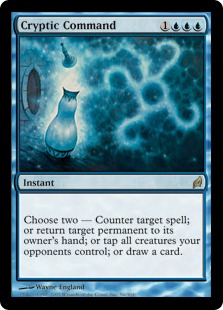 but I also know that the midrange list is usually better against Jund. They were overall equal against aggro decks, with the control lists better against green decks and midrange dominating red. Control was heavily favored against other Ancestral Vision decks but midrange was better against combo since it actually presented a clock with its disruption.
but I also know that the midrange list is usually better against Jund. They were overall equal against aggro decks, with the control lists better against green decks and midrange dominating red. Control was heavily favored against other Ancestral Vision decks but midrange was better against combo since it actually presented a clock with its disruption.
I could never figure out which deck was the optimal choice nor was I certain what I needed to sideboard for (particularly important for the control deck) so neither was ever a serious option going into States. I still don't know which is better to be honest; Joseph Presnell and the Milwaukee results suggest control while the Top 32 listings favor the midrange list. I think it may end up being personal preference more than anything, but we still need to see how the meta is shaking out (Sheridan, little help here?).
Taxing My Brain
I've mentioned it a few times but I really want Death and Taxes to be good in Modern. It's my weapon of choice for Legacy and I wish it had a cleaner Modern port. GW Hatebears is fine, but it lacks the disruption and soft-locks that make DnT special. It was almost good enough back in the Treasure Cruise days but Forked Bolt just ruined everything. I had some success with the deck, but I spent most of my time sweating and stressing about the Bolt so I couldn't really enjoy the game.
Since then every new set and banning has led me to try it out again but it's never been that successful. The taxes and mana disruption just never seemed to line up well. The release of Shadows Over Innistrad was no different, but this time Tom Ross had the same idea but better, with the inclusion of Thraben Inspector to finally give the deck some legs in fair matchups. I very nearly ended up playing this list at States:
Death and Taxes, by David Ernenwein (Test Deck for States)
I think that Tom was a little greedy including so many fun-ofs in his list and I like having a tenth two-drop for Vial over the fourth four-drop. I've gone with the split between Wingmare and Mindcensor because sometimes you really want that fifth Thalia and while Mindcensor can be extremely powerful, every time I rely on him he fails me. It might just be me, but I only wanted him (and even then just begrudgingly) against Scapeshift.
I mostly tested this deck online and it was crushing combo and control. Fetchland-heavy 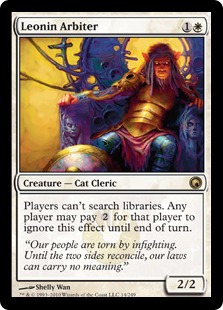 decks can just fold to Arbiter and combining pressure with induced inefficiency was often too much for those decks to come back from. The problem was that it proved to be a massive dog to colored linear aggro, especially the decks that went both wide and big like Humans, Allies, and Merfolk. Jund was also problematic since Lightning Bolt is too efficient for DnT to overcome and they always pack sweepers. Affinity was surprisingly reasonable even pre-board since Flickerwisp is so good against Arcbound Ravager and it runs mana-tight enough for Thalia to have an impact. Ultimately since I knew that Jund was going to be a large presence I decided not to run it.
decks can just fold to Arbiter and combining pressure with induced inefficiency was often too much for those decks to come back from. The problem was that it proved to be a massive dog to colored linear aggro, especially the decks that went both wide and big like Humans, Allies, and Merfolk. Jund was also problematic since Lightning Bolt is too efficient for DnT to overcome and they always pack sweepers. Affinity was surprisingly reasonable even pre-board since Flickerwisp is so good against Arcbound Ravager and it runs mana-tight enough for Thalia to have an impact. Ultimately since I knew that Jund was going to be a large presence I decided not to run it.
The problem is that since States I've been running the deck in paper and it has been crushing Jund and winning (even if just barely) against the linear aggro decks. 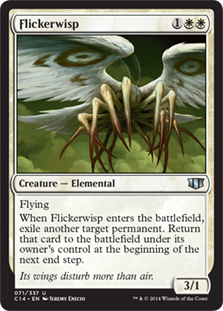 Against linear aggro I still cannot beat their really good curve-outs but when they have average hands DnT is suddenly grinding them out and winning, which never happened online. Paper Jund apparently has a weakness to Thalia that online Jund doesn't because they've just not been interacting and functioning as well as previously. Leonin Arbiter cannot be blamed for this---Jund is still working its way around him in most games, but somehow they're just not turning the corner like I expected. Even more unusual is that I've been racing (Racing!) with Jund. And winning. That isn't supposed to happen and never did online.
Against linear aggro I still cannot beat their really good curve-outs but when they have average hands DnT is suddenly grinding them out and winning, which never happened online. Paper Jund apparently has a weakness to Thalia that online Jund doesn't because they've just not been interacting and functioning as well as previously. Leonin Arbiter cannot be blamed for this---Jund is still working its way around him in most games, but somehow they're just not turning the corner like I expected. Even more unusual is that I've been racing (Racing!) with Jund. And winning. That isn't supposed to happen and never did online.
I haven't changed a card or altered my play style, and yet I'm getting very different results for these matchups. I haven't hit combo or control with DnT in paper so far, so I don't know if those results will change, but when bad matchups suddenly turn around that's something to investigate.
And the problem is that the only answer I currently have is variance. The decks in paper and online look similar enough that I can't explain the results from deck construction and there's really no way to measure skill so I'm left to wonder if the result just comes down to shuffling in reality vs. online. Of course this also means that I'll be sticking with the deck for a while just to see if this is indicative of the real life results.
The Broader Question
This is not even getting into whether or not mono-white DnT is where you want to be. Is  Pascal Maynard's WB deck a better choice? What about Eldrazi Taxes? Mono-white is the more reliable, particularly manawise, but the other options bring so much more power and disruption to bear that it's hard to argue against them. I may be having success in paper but the other versions have been posting results in far greater numbers than mono-white. And I still don't know if my results are even reliable.
Pascal Maynard's WB deck a better choice? What about Eldrazi Taxes? Mono-white is the more reliable, particularly manawise, but the other options bring so much more power and disruption to bear that it's hard to argue against them. I may be having success in paper but the other versions have been posting results in far greater numbers than mono-white. And I still don't know if my results are even reliable.
Even if my results are reliable, I'm not certain that my current list is even good. Naya Humans is gaining ground and Thalia is a natural fit for the deck. Why not just run Humans with some extra disruption and not bother with the rest of the deck? It seems to be worth testing at the very least.
Fighting Uncertainty
Do you recall hearing that a new product's failure was blamed on being focus-tested to death? Or the old cliché that the more you know the more you realize you know nothing? These are common problems in research and data analysis. The former case is the result of inbred research, where you increasingly aren't studying the test subject but the results of your results and losing sight of your purpose. The latter is caused by taking on too much at once and getting overwhelmed.
If you haven't picked up on it yet, this is where my testing recently has led me. I have very odd results and am looking at far too many variables, and as a result my decision-making was paralyzed. It's a common failing when you have too much information and can too clearly see the pros and cons of any decision, to make no decision---just like how I ended up playing Merfolk.
The trick to overcoming this issue is to take much smaller bites out of the problem. I'm asking too broad of questions about the decks I'm testing and getting lost. Rather than ask, "Which deck is better?" I should be asking, "Which deck am I better with?" In the case of UW, that answer is Titan. For DnT, rather than worrying if I have the right version of the deck I should be looking at the relative strengths and weaknesses of each. I'm letting my confusing data distract and intimidate me when I need to be approaching it more rationally and scientifically.
I'm good at that; it's how I approached my Thopter combo and Ancestral testing but I'm letting curiosity lead me astray. My testing is getting recursive as I effectively nerd snipe myself over interesting data and ignore more important questions. With this in mind as we move towards the Modern GP weekend, stay focused! Don't be me and lose sight of what you're actually looking for in your testing.





Great article, David! I think your points regarding Thopter + Sword and Vision are well-said (and I also commend you for being upfront about having changed your mind on the former interaction), and your thoughts on testing becoming inbred are excellent. We all have those pet cards that we want to shoe-horn into a deck in some form or fashion, but we have to beware not letting our bias cloud our thinking to the point where we’re missing out on quality cards (because it either conflicts with our pet card, or because our pet card just isn’t that good – we’ve all ben there).
I also like all 3 of the decks that you’ve presented here, but I’m most intrigued by the Death & Taxes one. Like you, I have long pined for the deck to be good in Modern, and I think the shell you’re presenting is quite reasonable and likely a step in the right direction. I know you brought up other versions of the deck, but I feel that overall I’m going to side with the one with the more consistent manabase. I think that Thraben Inspector is an intriguing choice for a 1-drop, though I’m not quite sure where it stacks up against the more canonical Dryad Militant and/or Judge’s Familiar (my experiences with Cursecatcher make me favor the Familiar, but then again D&T doesn’t have pump – I’d love to hear your opinions on this). A few more questions, though, if I may:
1. I’ve seen some discussion on Wall of Resurgence + Blinkmoth Nexus as a way to fend off “go wide + big” aggro decks (a 0/6 with a 3/3 that can become a 4/4 flier is a pretty good defensive package for 2W). It can also turn around and impose a potent flying clock on the opponent. Do you think this is something worth considering to shore up those Allies/Humans/Merfolk matchups? How about Wall + Darksteel Citadel for an indestructible blocker, or Wall + Mutavault for a 5/5 beatstick (which could have first strike thanks to Blade Splicer)?
2. How has the Eldrazi Displacer in the main performed? I’ve tested with it a bit online, and without Eldrazi lands to cast and activate, it always felt a tad clunky. I freely admit to not being very seasoned with it, however, so I’d like to hear your thoughts.
3. Has Serra Avenger been good? It has a good rate and flying + vigilance is very attractive against the likes of Affinity, but the fact that you can’t use it to press the offensive without Vial has made me a tad leery of it. I feel like its continued inclusion is somewhat of a holdover from days where the creature selection was more limited, but I freely admit I could be wrong on that. What say you?
Thanks Roland! I know that Inspector seems odd for Modern, but it works. White doesn’t get much card draw or cantripping and even if clues are a bit inefficient they’re worth it here. Back in the Treasure Cruise era Militant was the pick without question but her ability isn’t that relevant these days. A resurgence of Snapcaster Mage or Grixis would definitely change my mind but with Abzan Company and Jund sitting atop the metagame it’s not good enough. I was playing Familiar (and even tried Mana Tithe in that slot!) and it’s just too low impact right now. If Storm or Grishoalbrand were bigger that’d be a different story but since it doesn’t grow like Cursecatcher, I’d leave it at home.
1. The Wall is intriguing, though the mentioned interactions tend to be more cute than effective. If you’re going to go that route I think you need to build around it and plan for a midrange strategy rather than the more aggro strategy I’m running. This is mostly because Ghost Quarter is pretty common right now and really blanks the Wall and it’s still not that hard for the aforementioned decks to just swarm around the Wall.
2. It is a bit clunky, but as a 2-of it’s a great long game card. Having extra blinks for all your ETB effects is great, as is removing blockers. I’m not taking full advantage of it like Jim Davis, but it is still a solid card.
3. Yes. And also yes it is a holdover from Legacy but you really do need additional 2 costs for Vial and I wasn’t happy with the other options. I’ve tried everything from Spirit of the Labyrinth to Samurai of the Pale Curtain in that slot and none were very impressive. Avenger’s flying makes it the more reliable offensive creature once in play, so until something more disruptive that flies is printed I’m sticking with Avenger.
What a great read. This is what has happened to me in the last month. Trying to find the best shell for the Thopter combo. The same goes for modern hate bears. My main concerns are infect, burn and tron. I always end up having answers for 2 and none for the other. Again, good article would like to read more like this keep it up.
DnT is pretty good against those decks (Thalia really stifles Infect’s speed, Finks is great against Burn, Ghost Quarter is great against Tron) but I also struggled against those three when working on Thopters. Burn couldn’t beat the combo but beat the rest of the deck, I never had enough removal for Infect, and Tron was Tron vs Slow decks. I don’t think there’s room in any Thopter shell to beat all three, so I think you have to ditch Tron and focus on the other decks.
I run a very similar list but with 4 remand instead of Leak. This deck runs a lot of creatures. I run 3 Seas. Remand has been very good. All the cantrips just let me grind. This deck presents a very fast clock so remanding has been very good for me as Leak is just bad sometimes past turn 4 and Path to Exile doesn’t help the matter. In the side I run 3 negates which help a lot along with Geist of Saint Traft to present an even faster clock against Tron, Scapeshift and control. I run 1 Titan and 2 Avacyn main. She’s been testing very very well in this list with lots of creatures. I run another Titan in the side.
Have you not been disappointed with the full playset of Leak?
Not really though I can see why others might not feel the same. The clock is fast enough that Leak has stayed relevant for longer than usual in Path decks, and Titan is the kind of deck that needs to answer threats permanently when it uses a counter. However with Visions increasing in popularity Remand might be right in all circumstances. I’ve tried Geist before and have never been happy with him maindeck since there are so many creatures running around and really hate using sideboard space on him since if you want that to be your plan, you really need all four and that’s a little too much space for my taste.